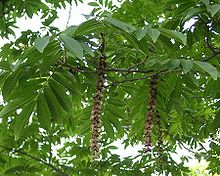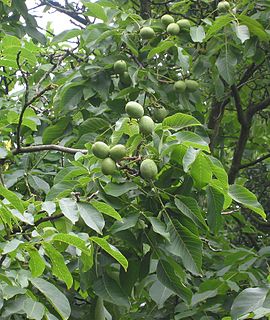Description
Pterocarya are deciduous trees, 10–40 m tall, with pinnate leaves 20–45 cm long, with 11–25 leaflets; the shoots have chambered pith, a character shared with the walnuts ( Juglans ) but not the hickories ( Carya ) in the same family.

In the fields of horticulture and botany, the term deciduous (/dɪˈsɪdʒuəs/) means "falling off at maturity" and "tending to fall off", in reference to trees and shrubs that seasonally shed leaves, usually in the autumn; to the shedding of petals, after flowering; and to the shedding of ripe fruit.

Pith, or medulla, is a tissue in the stems of vascular plants. Pith is composed of soft, spongy parenchyma cells, which store and transport nutrients throughout the plant. In eudicotyledons, pith is located in the center of the stem. In monocotyledons, it extends also into flowering stems and roots. The pith is encircled by a ring of xylem; the xylem, in turn, is encircled by a ring of phloem.
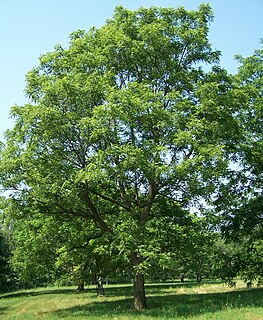
Walnut trees are any species of tree in the plant genus Juglans, the type genus of the family Juglandaceae, the seeds of which are referred to as walnuts. All species are deciduous trees, 10–40 metres (33–131 ft) tall, with pinnate leaves 200–900 millimetres (7.9–35.4 in), with 5–25 leaflets; the shoots have chambered pith, a character shared with the wingnuts (Pterocarya), but not the hickories (Carya) in the same family.
The flowers are monoecious, in catkins. The seed catkins when mature (about six months after pollination) are pendulous, 15–45 cm long, with 20–80 seeds strung along them.

A flower, sometimes known as a bloom or blossom, is the reproductive structure found in flowering plants. The biological function of a flower is to effect reproduction, usually by providing a mechanism for the union of sperm with eggs. Flowers may facilitate outcrossing or allow selfing. Some flowers produce diaspores without fertilization (parthenocarpy). Flowers contain sporangia and are the site where gametophytes develop. Many flowers have evolved to be attractive to animals, so as to cause them to be vectors for the transfer of pollen. After fertilization, the ovary of the flower develops into fruit containing seeds.
A catkin or ament is a slim, cylindrical flower cluster, with inconspicuous or no petals, usually wind-pollinated (anemophilous) but sometimes insect-pollinated. They contain many, usually unisexual flowers, arranged closely along a central stem which is often drooping. They are found in many plant families, including Betulaceae, Fagaceae, Moraceae, and Salicaceae. For some time, they were believed to be a key synapomorphy among the proposed Hamamelididae, also known as Amentiferae. Based on molecular phylogeny work, it is now believed that Hamamelididae is a polyphyletic group. This suggests that the catkin flower arrangement has arisen at least twice independently by convergent evolution, in Fagales and in Salicaceae. Such a convergent evolution raises questions about what the ancestral inflorescence characters might be and how catkins did evolve in these two lineages.
The seeds are a small nut 5–10 mm across, with two wings, one each side. In some of the species, the wings are short (5–10 mm) and broad (5–10 mm), in others longer (10–25 mm) and narrower (2–5 mm).

A seed is an embryonic plant enclosed in a protective outer covering. The formation of the seed is part of the process of reproduction in seed plants, the spermatophytes, including the gymnosperm and angiosperm plants.

A nut is a fruit composed of an inedible hard shell and a seed, which is generally edible. In general usage, a wide variety of dried seeds are called nuts, but in a botanical context "nut" implies that the shell does not open to release the seed (indehiscent). The translation of "nut" in certain languages frequently requires paraphrases, as the word is ambiguous.
Species
There are six species.
Another species from China, the wheel wingnut with similar foliage but an unusual circular wing right round the nut (instead of two wings at the sides), previously listed as Pterocarya paliurus, has now been transferred to a new genus, as Cyclocarya paliurus .
Uses
Wingnuts are very attractive, large and fast-growing trees, occasionally planted in parks and large gardens. The most common in general cultivation outside Asia is P. fraxinifolia, but the most attractive is probably P. rhoifolia. The hybrid P. × rehderiana, a cross between P. fraxinifolia and P. stenoptera, is even faster-growing and has occasionally been planted for timber production. The wood is of good quality, similar to walnut, though not quite so dense and strong.

Hornbeams are hardwood trees in the flowering plant genus Carpinus in the birch family Betulaceae. The 30–40 species occur across much of the temperate regions of the Northern Hemisphere.

Hickory is a type of tree, comprising the genus Carya. The genus includes 17 to 19 species. Five or six species are native to China, Indochina, and India (Assam), as many as 12 are native to the United States, four are found in Mexico, and two to four are from Canada. A number of hickory species are used for products like edible nuts or wood.

The hazel (Corylus) is a genus of deciduous trees and large shrubs native to the temperate Northern Hemisphere. The genus is usually placed in the birch family Betulaceae, though some botanists split the hazels into a separate family Corylaceae. The fruit of the hazel is the hazelnut.

Ostrya is a genus of eight to 10 small deciduous trees belonging to the birch family Betulaceae. Common names include hop-hornbeam and hophornbeam. It may also be called ironwood, a name shared with a number of other plants.

Corylus maxima, the filbert, is a species of hazel native to southeastern Europe and southwestern Asia, from the Balkans to Ordu in Turkey.

Juglans regia, the Persian walnut, English walnut, Circassian walnut, or especially in Great Britain, common walnut, is an Old World walnut tree species native to the region stretching from the Balkans eastward to the Himalayas and southwest China. The largest forests are in Kyrgyzstan, where trees occur in extensive, nearly pure, walnut forests at 1,000–2,000 m altitude—notably at Arslanbob in Jalal-Abad Province. It is widely cultivated across Europe.
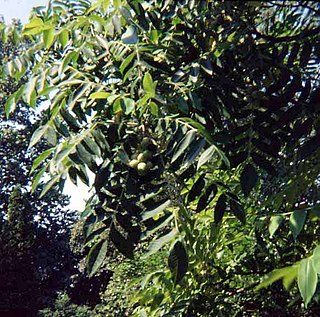
Juglans ailantifolia, the Japanese walnut, is a species of walnut native to Japan and Sakhalin. It is a deciduous tree growing to 20 m (66 ft) tall, rarely 30 m (98 ft), and 40–80 cm stem diameter, with light grey bark. The leaves are pinnate, 50–90 cm long, with 11-17 leaflets, each leaflet 7–16 cm long and 3–5 cm broad. The whole leaf is downy-pubescent, and a somewhat brighter, yellower green than many other tree leaves. The male flowers are inconspicuous yellow-green catkins produced in spring at the same time as the new leaves appear. The female flowers have pink/ red pistils. The fruit is a nut, produced in bunches of 4-10 together; the nut is spherical, 3–5 cm long and broad, surrounded by a green husk before maturity in mid autumn.

Ostryopsis is a small genus of deciduous shrubs belonging to the birch family Betulaceae. The species have no common English name, though hazel-hornbeam has been suggested, reflecting their similarities to the closely related hazels and hop-hornbeams.
Annamocarya is a genus of flowering plants in the family Juglandaceae, containing only one species, Annamocarya sinensis, native to southwestern China and northern Vietnam. It is related to the hickories, and was formerly included in the same genus Carya, as Carya sinensis, but also shares a number of characteristics with the walnuts in the genus Juglans. It is grouped with Carya in the subtribe Caryinae. It is sometimes called Chinese hickory or beaked hickory.

Amentotaxus is a genus of conifers (catkin-yews) comprising five species, treated in either the Cephalotaxaceae, or in the Taxaceae when that family is considered in a broad sense. The genus is endemic to subtropical Southeast Asia, from Taiwan west across southern China to Assam in the eastern Himalaya, and south to Vietnam. The species are evergreen shrubs and small trees reaching 2–15 m tall.

Acer buergerianum is a species of maple native to eastern China, Taiwan and Japan.
Flora of Azerbaijan or Vegetation of Azerbaijan refers to the plants, trees, flowers which can be found in Azerbaijan.
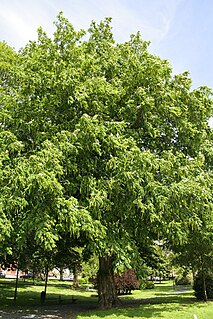
Pterocarya fraxinifolia is a species of tree in the Juglandaceae family. It is commonly known as the Caucasian wingnut or Caucasian walnut. It is native to the Caucasian region Armenia, Azerbaijan, Georgia, Iran, Russia, Ukraine and Turkey. It was introduced to France in 1784, and to Great Britain after 1800.
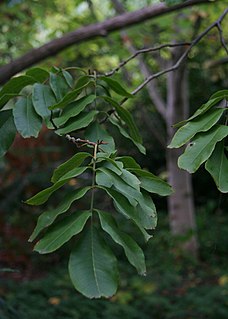
Cyclocarya is a genus of flowering plants in the family Juglandaceae, comprising a single species Cyclocarya paliurus, formerly treated in the genus Pterocarya as Pterocarya paliurus. It is native to eastern and central China.

Corylus heterophylla, the Asian hazel, is a species of hazel native to eastern Asia in northern and central China, Korea, Japan, and southeastern Siberia.
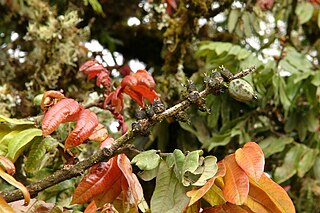
Alfaroa costaricensis, also known as campano chile, chiciscua, gaulin, gavilán Colorado, or gavilancillo, is nut bearing timber tree in the Juglandaceae family. It is native to the Neotropics, from Mexico, through Central America to Colombia.

Pterocarya stenoptera is a small-winged wingnut tree of the Juglandaceae family. It is originally from Southeast China.
P. japonica may refer to:
